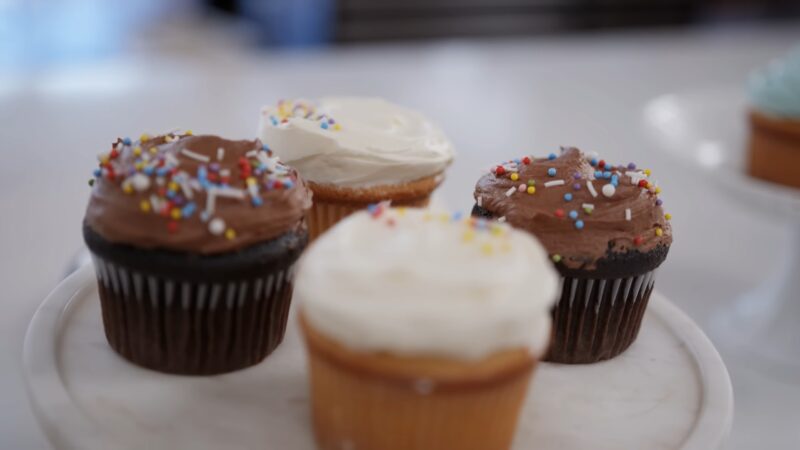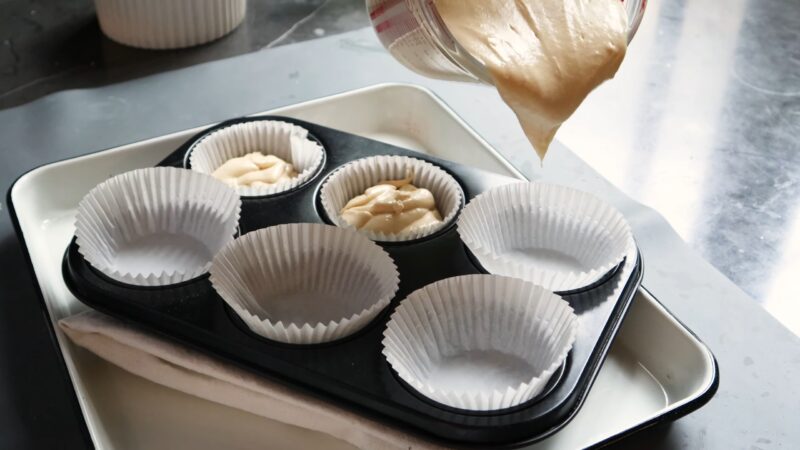Cupcakes: those small, joyful delights that brighten up any occasion. Whether it’s a child’s birthday party, a casual get-together, or just a treat for yourself, cupcakes have a special way of spreading happiness.
Yet, amidst the fun and frosting, a practical question often arises: How long do these miniature cakes remain fresh and enjoyable? We will provide more details about this topic in the following sections.
How Different Conditions Can Impact the Freshness?

When discussing the shelf life, it’s not just about stating how long they last under different conditions, but also understanding why and how these conditions impact their freshness.
- At Room Temperature: The reason they last for 1-2 days at room temperature is largely due to the interplay between moisture content and microbial growth. These delicious sweets, especially those with high sugar and fat content, can provide a fertile ground for bacteria and mold if not stored properly. The absence of preservatives in homemade ones also plays a role here, as commercial products might last a bit longer due to added preservatives. Environmental factors like humidity and temperature also significantly affect their shelf life. High humidity can lead to soggy cupcakes, while extreme temperatures can accelerate spoilage.
- In the Refrigerator: The cooler temperatures of a refrigerator slow down bacterial growth, which is why refrigerated cupcakes last up to a week. However, refrigeration can also have negative effects. It can alter the texture of the cake and frosting, often leading to dryness. This is because refrigerators can draw moisture out of the cupcakes. To mitigate this, proper storage in airtight containers is crucial. This helps maintain moisture levels and prevents the cupcakes from absorbing odors of other foods in the fridge.
- In the Freezer: Freezing cupcakes is an excellent way to extend their shelf life to 2-3 months. The low temperatures halt microbial growth and prevent spoilage. However, the process of freezing and thawing can impact the cupcakes’ texture and flavor. To prevent freezer burn, a common issue with improperly stored frozen foods, wrapping cupcakes tightly in plastic wrap before placing them in a zip-lock bag is essential. When thawing, it’s important to do so gradually at room temperature to ensure the cupcakes retain their moisture and texture.
How Does the Type of Liner Affect Shelf Life?

The type of liner used can have a subtle but notable impact on a cupcake’s freshness. Standard paper liners are breathable, allowing for some air circulation which can slightly dry out the cupcakes over time.
- Foil liners, on the other hand, tend to keep moisture in better, which can be beneficial for maintaining softness but might also encourage mold growth if the cupcakes are stored for an extended period.
- Silicone liners, being reusable and non-porous, offer a middle ground, helping to retain moisture without the risk of paper liners. However, the most crucial factor remains how quickly the cupcakes are consumed and how they are stored post-baking.
- Cupcake liners can provide some protection, but proper storage in an airtight container is key to extending shelf life, regardless of the type of liner used.
Ingredients and Their Impact on Freshness
Each ingredient in a cupcake plays a role in determining its shelf life. Understanding this can help bakers make adjustments for longer-lasting treats.
- Flour, Sugar, and Eggs: These foundational ingredients contribute to the structure and flavor of the cupcake. While they don’t directly affect shelf life, their ratios can influence the cupcake’s moisture content. A higher ratio of sugar, for instance, can act as a preservative to some extent, as sugar binds with water and makes it unavailable for microbial growth.
- Dairy Products: The inclusion of dairy products such as milk, butter, or yogurt can add richness to cupcakes but also reduces their shelf life. Dairy is prone to bacterial growth, which can lead to spoilage. This is particularly important for fillings and frostings, where dairy content is usually higher.
- Add-ins: Ingredients like fruits, nuts, or vegetables add flavor and texture but also introduce additional factors that can affect shelf life. Fresh fruits and vegetables can increase moisture content, potentially leading to quicker spoilage due to mold growth. Nuts can add oils that may go rancid over time, especially if they are stored in warm conditions.
Why is Frosting Important?

The type of frosting used on cupcakes not only defines their taste and aesthetic appeal but also significantly influences their storage requirements and shelf life.
- Buttercream and Fondant: These are popular choices for their versatility and stability. Buttercream, made primarily from butter and sugar, has a high fat content which can protect the cupcake from air exposure, thus slowing down the drying process. Fondant, typically made from sugar, water, and gelatin or marshmallows, creates a sealed layer around the cupcake, which helps maintain freshness. However, these frostings can become hard or lose their texture if exposed to extreme temperatures.
- Cream Cheese and Whipped Cream: These frostings are more delicate due to their dairy content. Cream cheese frosting, while delicious, is prone to bacterial growth if left unrefrigerated for extended periods. Whipped cream frosting, being light and airy, is susceptible to collapse and separation at room temperature. Both types require refrigeration to maintain both safety and quality.
Storage Techniques
Proper storage is not just about keeping them edible; it’s about maintaining their flavor, texture, and overall quality.
- Room Temperature Storage: This is suitable for short-term storage of unfrosted or buttercream/fondant frosted cupcakes. To ensure they remain moist and fresh, they should be stored in an airtight container. The container prevents air exposure, which can lead to staleness. Additionally, keeping cupcakes away from direct sunlight and sources of heat is crucial, as these can cause the frosting to melt or the cake to dry out.
- Refrigerating Cupcakes: This method is best for cupcakes with perishable toppings or fillings. When refrigerating, it’s important to let the cupcakes cool completely before storage. Warm cupcakes can lead to condensation inside the container, making them soggy. Separating cupcakes with parchment paper can prevent them from sticking together or ruining the frosting.
- Freezing Cupcakes: For long-term storage, freezing is the most effective method. It’s vital to wrap each cupcake individually in plastic wrap and then place them in an airtight container or zip-lock bag. This double layer of protection guards against freezer burn and flavor absorption from other foods in the freezer. When ready to eat, thawing the cupcakes at room temperature ensures they return to their original texture and flavor profile.
Signs of Spoilage

Identifying when a cupcake is no longer good to eat is crucial to prevent foodborne illnesses.
- Mold: The most obvious sign of spoilage is the presence of mold. Mold can appear as fuzzy spots in various colors. Consuming moldy food can be harmful, so any cupcakes showing signs of mold should be discarded immediately.
- Off Smell: A sour or unusual smell is a strong indicator that the cupcake has gone bad. This is often due to bacterial growth or chemical changes in the ingredients. Trusting your sense of smell is important, as it can detect spoilage that isn’t visually apparent.
- Texture Changes: Fresh ones are typically soft and moist. If a cupcake feels hard, dry, or crumbly, it’s likely stale. While stale cupcakes might not be harmful to eat, they certainly won’t offer the best eating experience.
- Taste: If the cupcake looks and smells fine but tastes off, it’s best to err on the side of caution and discard it. A change in taste can indicate spoilage that isn’t otherwise detectable.
Additional Details
When dealing with cupcakes, there are always special scenarios and considerations to take into account.
- Dietary Restrictions: Cupcakes that are gluten-free, vegan, or designed for other dietary restrictions might have a different shelf life than traditional cupcakes. For example, gluten-free products might dry out faster due to the nature of gluten-free flours. Vegan options, lacking eggs and dairy, might last a bit longer but could also have texture issues over time.
- High Altitude: Baking and storing at high altitudes can be different due to lower air pressure and humidity levels. These cupcakes might dry out faster, and adjustments in storage methods might be needed to maintain freshness.
FAQs
Can I leave cupcakes out overnight?
Yes, if they do not contain perishable ingredients and are stored properly. However, consider the room’s temperature and humidity. Hot, humid environments can accelerate spoilage.
How do I know if a cupcake is still good?
Check for visible signs of mold, sniff for off odors, feel the texture, and taste a small piece. If any of these factors seem off, it’s safer to discard the cupcake.
Does freezing cupcakes affect their taste?
If properly wrapped and stored, freezing should not significantly alter the taste of cupcakes. However, there might be slight changes in texture, especially if they are stored for more than three months.
Can I decorate cupcakes a day before serving?
Yes, you can decorate cupcakes a day in advance. Just ensure they are stored in an airtight container to maintain freshness and prevent the frosting from drying out.
Summary
Paying attention to the details of how you prepare, decorate, and store your cupcakes can make a significant difference in how long they stay fresh and enjoyable. With this in-depth knowledge, you’re well-equipped to handle cupcakes for any occasion, ensuring they remain as delightful on the last day as they were on the first.
